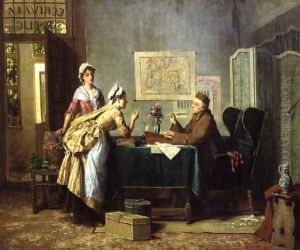Z. Carabin Paintings
François-Rupert Carabin was a French sculptor, cabinetmaker, and photographer, known for his intricate wood carvings and sculptural furniture that often reflected Art Nouveau motifs. Born on March 17, 1861, in Saverne, Alsace, Carabin showed an early interest in the arts, though his initial career path led him towards a job in the postal service. His passion for art, however, couldn't be sidelined for long, and he eventually devoted himself to studying sculpture and the applied arts in Strasbourg before moving to Paris to further his education and career.
Carabin's work is characterized by its detailed craftsmanship, innovative use of materials, and the sensual, sometimes erotic, themes that pervade his sculptures and furniture pieces. His art was heavily influenced by the Symbolist movement, and he often incorporated themes of nature, femininity, and mythology into his pieces. Carabin was a contemporary of other Art Nouveau artists like Alphonse Mucha and Hector Guimard, and his work contributed to the movement's ethos of integrating art into everyday life, blurring the lines between functional objects and artistic creations.
Throughout the late 19th and early 20th centuries, Carabin gained recognition for his contributions to the decorative arts, participating in various exhibitions, including the Exposition Universelle in Paris in 1900. His work was not only appreciated in France but also internationally, with pieces finding their way into collections across Europe and America. Despite his success, Carabin's name is not as widely recognized today as some of his contemporaries, though his work remains a fascinating study for those interested in the Art Nouveau movement and the intersection of sculpture and decorative arts.
François-Rupert Carabin's career reflects the dynamic changes in art and society during his lifetime, moving from traditional sculptural forms to more avant-garde expressions. He died on February 28, 1933, in Strasbourg, leaving behind a legacy that continues to be studied and admired for its originality, craftsmanship, and unique aesthetic vision. His contributions to the Art Nouveau movement and the decorative arts underscore the importance of innovation and the breaking of boundaries between different art forms.
